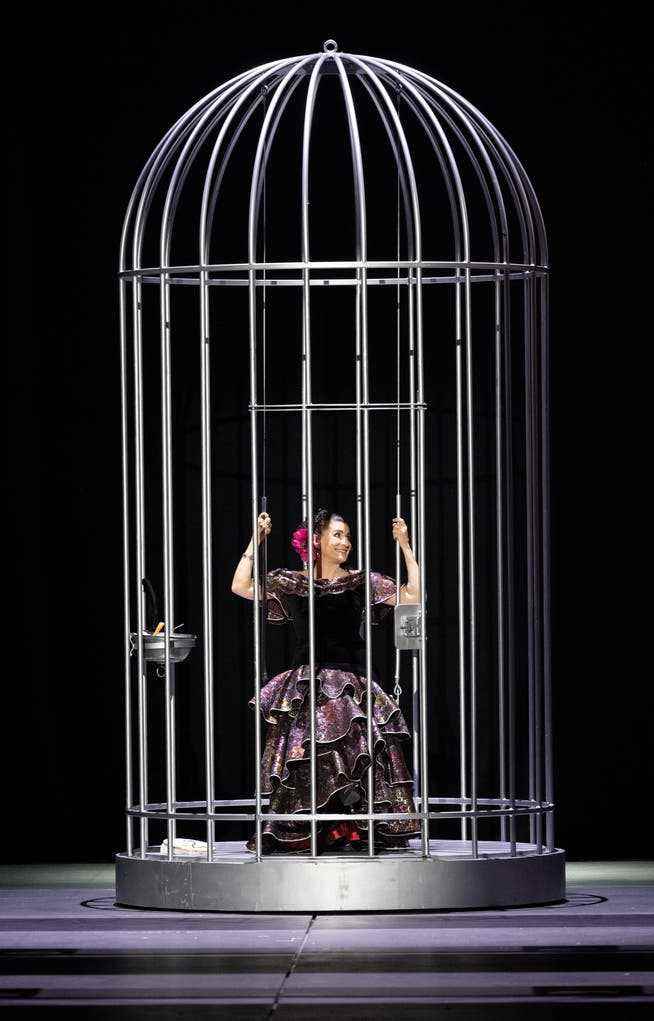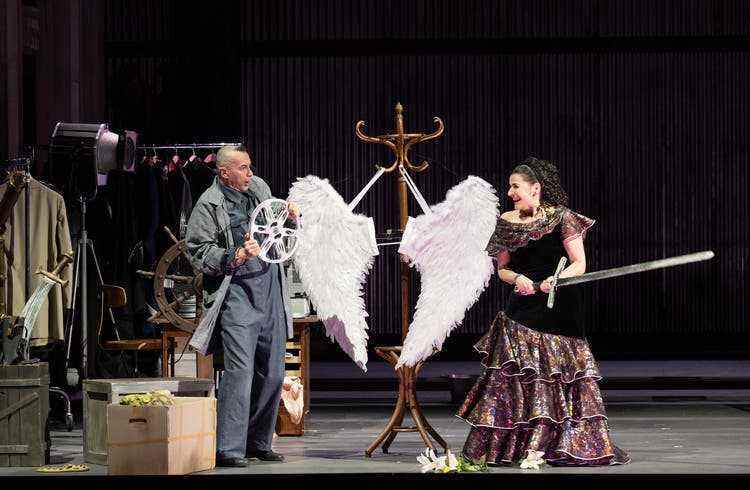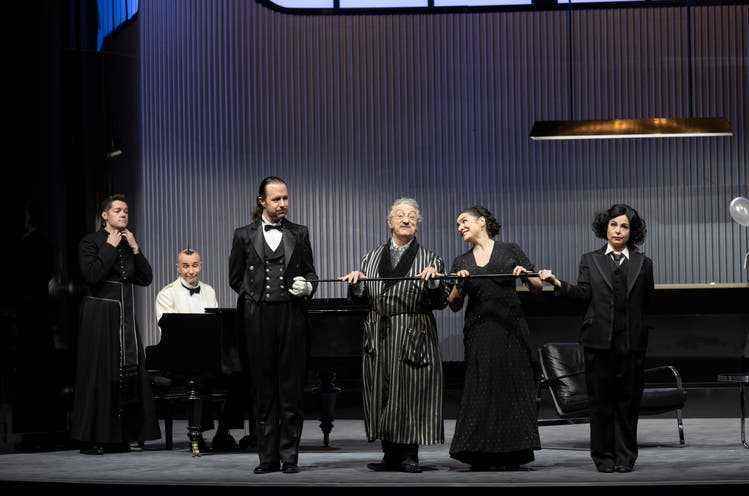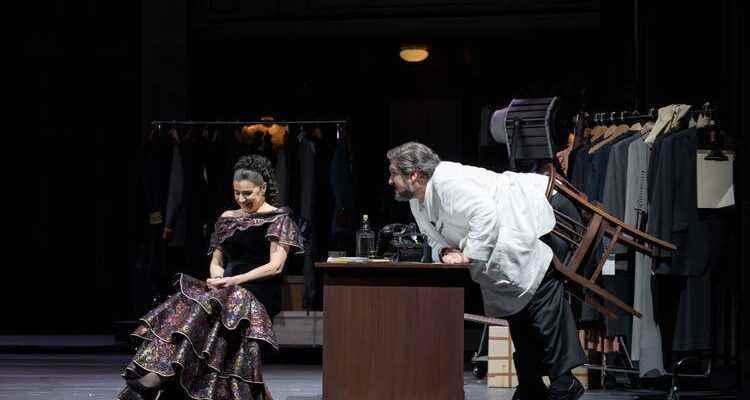The diva is allowed to show herself in a flamenco look, and the singing jack of all trades makes nonsense to his heart’s content: Rossini’s “Barber of Seville” turns out to be a chaotic children’s paradise in the film dreamland at the Whitsun Festival.
No gag is left unused: Cecilia Bartoli (Rosina) and Nicola Alaimo (Figaro) in Rolando Villazón’s production of Rossini’s “Barber of Seville”.
More than 150 operas have been counted playing in Seville, including some of the most famous, from Mozart’s Don Giovanni to Beethoven’s Fidelio and Bizet’s Carmen. The romantic enthusiasm for Spain, especially in the 19th and early 20th centuries, saw the city as the perfect projection surface for an explosive mixture of restrictive Catholicism and smoldering sexuality, of patriarchy and wildly rebellious women.
In the case of Cecilia Bartoli, on the other hand, flamenco in particular aroused interest in the Andalusian capital. She discovered him when she was still at school and at times danced in a semi-professional group herself. A lot of flamenco was therefore also danced on the past Whitsun weekend, which Bartoli, as artistic director of the Salzburg Whitsun Festival, this time devoted entirely to the musical dreams of Seville. These can be heard at a gala with excerpts from a number of Seville operas, for which she has invited colleagues such as Plácido Domingo, Piotr Beczała and Maria Agresta. And you can probably see it as a return to a girl’s dream when Bartoli shows himself in a flamenco dress at the opening premiere – in the very opera that already bears the name of the city in the title: Gioachino Rossini’s “Barber of Seville”.
Movie star Bartoli
Of course, it is a fiction when Bartoli sings the role of Rosina here, with which she made her professional debut more than thirty years ago: Actually, it is the role of a female teenager who is captured by the radiantly youthful Count Almaviva from the claws of the authoritarian Doctor Bartolo is freed. Not for a moment does one believe that la Bartoli would bow to such a coercive regime during the performance in the Salzburg House for Mozart – not even vocally. Their mezzo depth sounds too cooingly self-confident, the coloratura too artificial and polyphonic ornate.

Little bird Rosina (Cecilia Bartoli) in the cage. Luckily the bars are made of rubber.
For the performance aria “Una voce poco fa” she is rolled onto the stage in a huge birdcage, the bars of which soon prove to be as flexible as rubber. The directing is not about realism – Bartoli entrusted it to a well-known singer colleague: Rolando Villazón, who used his fame and popularity in the early late autumn of his tenor career to also appear as a director or novelist.
One learns from his production of Rossini’s most-performed opera that he is also a film fanatic (the production will be taken over to this year’s Summer Festival). He transfers her to a film set, in the background of which stereotypical cinema images flicker with relish, the star of which is Bartoli, of course. Which in turn gives Villazón the opportunity to fulfill all boyhood dreams and either send a Mexican mariachi band onto the stage or a horde of old Romans who, yes, are put in their place by Frankenstein’s monster.
Original sound Rossini
The singers join in happily: Ildebrando D’Arcangelo, for example, actually the music teacher Basilio in the opera and a world-class bass, sneaks through the set with the clawed fingers of Murnau’s Nosferatu. Nicola Alaimo is a Figaro, as he is in the book, a real popular figure: his baritone sounds expansive and self-confident, which he nevertheless knows how to docilely adapt to the finesse of Rossini’s wordplay. The fact that in the end Edgardo Rocha as Almaviva not only conquers Bartoli’s heart is less due to the Zorro costume that Villazón put him in than to the fact that vocally he shows all the advantages of a real tenore di Grazia: confident in the high register and perfectly elegant in the Legato, full of youthful power and yet flexible in the coloraturas. He shares his (often deleted) closing aria “Cessa di più resistere” with Bartoli – a friendly gesture, also towards the audience, who then want to hear more from the diva than the revival of a youth role.
In the orchestra pit, as in previous years, the boss relies on the ensemble that she herself brought to life at the Monte Carlo Opera: “Les Musiciens du Prince – Monaco” are an early music orchestra, which, with Rossini, is still quite unusual , plays on original instruments. The principles of historical performance practice as conducted by Gianluca Capuano are unmistakable: the winds clearly gain in weight compared to the strings, which sound drier and scratchier than usual on their gut strings. Capuano allows for sharp, even fragmentary phrasing, the music buzzes, snarls, hums, whistles, depending on the scene, and is sometimes driven forward percussively by the guitar or – after all, we are in Seville – the castanets, which Rossini did not notate.
The fortepiano is always present in terms of sound, and its role as a continuo, together with a cello, is expanded, especially in the recitatives. Andrea Del Bianco improvises over the basses, plays around the singers’ voices, repeatedly intersperses material that does not come from Rossini, right through to nostalgic film music quotations. This follows a stylistic trend that the conductor Teodor Currentzis recently tried out with Mozart at the Salzburg Summer Festival: Theatricality takes precedence over obstinately following the musical text, dealing with the music is made more flexible, also in terms of closer coordination with the direction .

The stage is filled with props, even Rosina (Cecilia Bartoli) is apparently in the wrong play at some point.
gag parade
Villazón makes full use of the newly gained space to let his passion for the clownesque run free. The stage is downright filled with obscure props. He also incorporated the quick-change artist Arturo Brachetti into the production, who always finds a crooked wig somewhere. As an omnipresent factotum, of course, he displaces Figaro, who is assigned precisely this role in the play. In general, the story increasingly fades into the background in favor of the more and more annoying gag parade. As a director, Villazón seems to have the same problems as a novelist: he has to constantly duplicate everything, doesn’t like to let any idea go to waste and loses the thread of it.
However, Rossini is not a romantic who would lose himself in the moment; he rather pursues a classical ideal, schooled on Mozart, in which the drivenness of the plot is subtly absorbed by the closed musical numbers. The fact that the conducting follows Villazón’s reading and gives him unconditional space for every antics throws the piece’s inner rhythm out of step. The evening, which extends to an unusual three and a half hours despite the fast tempi, lacks scenic and musical pause – and thus also the space for the magic of love, which Rossini has so finely balanced against humor. There is not enough of the eroticism of Seville in the chaotic children’s paradise.

